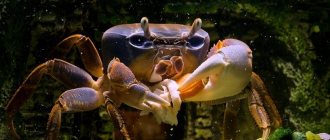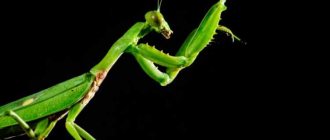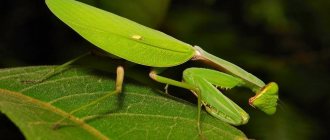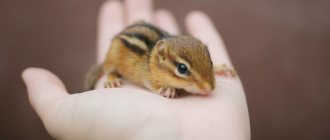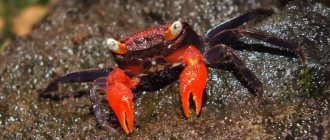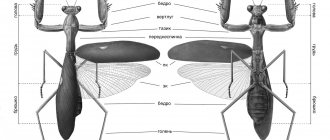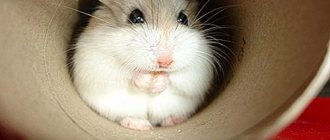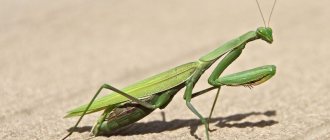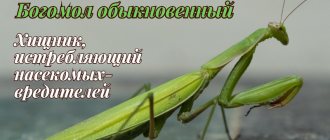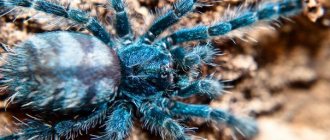- Insects
The common mantis, or religious mantis (lat. Mantis religiosa) is an insect from the family of true mantises of the order Mantis. A large predatory insect with forelimbs adapted for grasping food. Reaches 42–52 mm (male) or 48–75 mm (female) in length. The largest and most widespread praying mantis in Europe.
What to feed praying mantises? Detailed analysis of food objects
Praying Mantises, Forage Insects
For a person who is just about to take home any predatory animal, this is perhaps the most difficult preparatory stage. Not everyone is ready to feed someone to someone, even if they are already dead. This trick won’t work with a praying mantis either, because they only hunt moving objects and are unlikely to eat a corpse under normal conditions. And the main food for praying mantises is their closest relatives - cockroaches. That is, not only will you have to watch a praying mantis eat someone alive, but you will also have to specifically keep a culture of cockroaches at home. It sounds terrible, but it's not all bad. We are not talking about domestic cockroaches, but tropical ones, which in the conditions of our apartment, even if they escape, will not be able to live for long (an individual individual can last a couple of months without food, but will not be capable of growth and reproduction). And they look much nicer, although, depending on who... I won’t write about the contents of certain feed crops; there is enough information about this on the Internet. And we have a theme of praying mantises and what they eat, so we’ll make a short list.
Springtail (Collembola). ! This section is temporarily under development (I apologize for the inconvenience caused to your praying mantises). !
Drosophila. Fruit fly is the ideal and most popular food for early instar nymphs. It is sold in glasses along with the substrate in almost all major cities, and, if desired, you can dilute it yourself on fermented fruits (banana, apple, etc.).
Marbled cockroach (Nauphoeta cinerea). This is the main food for most species of mantises. Marbles are nutritious, large and do not accumulate harmful substances. But there are a number of disadvantages associated with their content: they are fast, run on any surface, emit a smelly secretion when irritated, and are quite strong. Before feeding, it is recommended to press down the head of the cockroach, because it can bite the mantis, and there have been cases when an accidental bite led to dire consequences.
Sphodromantis viridis eating Marbled cockroach
Pale cockroach (Phoetallia pallida). Rare and hard to find, but my favorite type of food. Newborn cockroaches are small enough to be eaten by the first instar nymphs of large mantises, and they themselves have no smell and do not excrete any nasty things, although they run on glass. They are not as strong and biting as Marbles, so they are suitable as food for praying mantises, which specialize in winged food. They may refuse other cockroaches.
Gongylus gongylodes eating a Pale cockroach
Locust (Locusta migratoria, Schistocerca gregaria). This is the best food for pregnant females and late instar praying mantises. Locusts are very nutritious, cannot harm the praying mantis and live on apples for a long time. Many species cannot be successfully maintained on cockroaches alone, and locusts are the best solution to this problem. There are 2 types of it: migratory and desert. In principle, there is not much difference between them, except that the desert locust is larger and more difficult to maintain.
Sphodromantis lineola eating Migratory Locust
Blowfly (Lucilia). The fly is considered to be an important addition to the praying mantis's main food and, for many species, the best you can get during the winter. Praying mantises take flies more readily than cockroaches, and the chance of getting poisoned is almost zero. You can get a fly at a fishing store if you ask for a maggot that has already been lying down. There is a chance that such maggots will be given to you for free, since not a single fisherman will take it. The fly will spend about a week in the puparia (pupa) stage, after which it will be ready for use, but this period can be extended by placing the maggot in the refrigerator. Attention!!! You can’t feed a praying mantis with maggots, it’s poison for him. Only specialized groups of insects feed on maggots, but certainly not mantises.
Wax moth (Galleria mellonella). In short, this is an analogue of the hawk moth for small species of mantises. A small, agile butterfly sold at the caterpillar stage of the last molt. Ideal food for Empusidae and other specialists in winged insects, which may not be very comfortable on flies alone.
Pseudempusa pinnapavonis eating Fireweed
Wine hawk moth (Deilephila elpenor). Residents of Europe have the opportunity to provide additional nutritious food to their praying mantises thanks to a unique butterfly - the Wine Hawk Moth. You can read about the hawk moth itself and its characteristics on the Internet, but I want to tell you why exactly it is unique, and why this particular species is being considered here. The fact is that the wine hawk moth does not have a clear boundary of pupal diapause. Placed in the refrigerator at the end of September, they will come out the moment you take them out, starting in January. Thus, for most of the winter you can have additional food for large females, the amount of which depends on the number of caterpillars you catch. Also, as an option, you can catch the hawk moth in the light and raise the caterpillars yourself, as I do, but catching a female with eggs is not always easy. Let me make a reservation that this is far from the only species of wintering butterflies, and you can conduct experiments with representatives of different species and families.
Hierodula sp. Sri Lanka eats Hawkmoth
Tobacco hawk moth (Manduca sexta). An analogue of Wine is Tobacco Hawkmoth, sold in pet stores. Pros of hawk moth: it is larger, it emerges from the pupa in 2 weeks without diapause, you can take it at any time. Disadvantages: the caterpillars will have to be fed, and food for them (like themselves) will cost a pretty penny, and the size of the butterfly itself is too large, so only the heaviest females will eat it.
Other types of food. Nowadays, there are many food crops that you can offer your praying mantis. This is a springtail, these are various “noble” species of cockroaches, pebbles, etc. In principle, you can use all this as needed without fear for the health of your mantises, but do not forget that, in addition to emergency options, the main food and useful supplements must be present to it. Emergency does not mean prohibited. Simply, they are not nutritious or convenient. I talk about all the known problems and problematic foods below.
Fruits. I don’t know who did it first and why, but he thought of giving the praying mantis a banana. And, you know, the praying mantis began to eat it. Then it turned out that he could gnaw peaches, grapes and much more. But this is not good. This is a sign of a lack of vitamins and moisture; the mantis is more likely to try to lick the juice than to eat the fruit. Someone says that you need to offer fruits to the mantis, but I say that there is a much more correct method: monitor whether the mantis has enough water (section below) and feed these fruits not to it, but to the food insects that it will soon eat . This way, all the useful substances will enter the praying mantis’ body naturally, and you won’t have to do, um, strange and wrong things. By the way, it is very useful to feed the CO with honey before feeding.
Insect Reproduction
Despite its short lifespan, the average price for one praying mantis is about 1 thousand rubles. But these insects are very fertile, and the female can lay up to 300 eggs at a time.
The main thing that everyone knows about praying mantises is that during mating, the female bites off the male’s head. She needs a lot of protein to carry her eggs, so she dines with her partner. In captivity, a well-fed insect can behave this way only in exceptional cases; the main thing is not to forget to feed it on time.
Small nymphs appear after 30–60 days at an air temperature of about 30 degrees and high humidity. The warmer it is, the faster the offspring will appear.
The tiny praying mantises are placed in a separate terrarium and fed fruit flies. As they grow up, they will have to go through several molts.
The praying mantis is an ideal pet that will rid the house of flies and cockroaches and relieve stress for the owner. Insects are happy to make contact with humans; they are very beautiful and completely harmless.
The praying mantis is a fascinating insect widely distributed throughout the world. He is an excellent choice as a pet. Even people who don't like bugs can be convinced to enjoy the antics of the praying mantis. For example, did you know that it turns its head to look over its shoulder (in fact, it is the only insect that can do this!)? Mantises come in a variety of colors, such as flower-pink (orchid mantis - Hymenopus Coronatus
) and white, although most are brown or green. The type of mantis you can keep depends on where you live and whether you got it off the street or from an exotic pet store. Raising a praying mantis is quite easy and a lot of fun. You'll likely learn a lot more about this unique and interesting insect just by observing its daily antics.
What is not advisable to feed praying mantises:
Cricket (Gryllidae). The cricket itself is a harmless insect. If you caught it on the street, you can safely feed it. But the crops sold in pet stores live on artificial feed, which causes harmful bacteria to develop in the crickets’ bodies. The immunity of praying mantises very often cannot cope with such an infection, and cases of cricket poisoning have been recorded not only among them. Many people (usually Sphodromantis holders) will try to confuse you and tell you that this is all nonsense. And you, of course, will believe them, which you will regret. Why Sphodromanthis? Yes, because these are one of the most powerful mantises in the culture, which practically no infection can take (but a cricket can cope with them). By the way, people who breed crickets themselves claim that praying mantises live well on them, but, as you understand, not a single good keeper is going to test their theories on their own living creatures.
Cricket dust. This is a separate topic. Newborn crickets have not yet accumulated all sorts of rubbish in their bodies, so they are perfectly fed to the first moulting mantises. But I will leave this type of food here, because it seems to me that it is completely useless. Dust is more expensive than fruit flies, does not reproduce (it ends in 3-4 days), requires separate feeding, and is not juicy and rich in nutrients. That is, it is inferior to Drosophila in all respects.
Lionfly (Hermetia illucens). In addition to the cricket, there are a number of food animals that are not recommended for the praying mantis. This is, first of all, the Black Lion. Lion fly larvae serve as nutritious food for reptiles, so recently they can be increasingly seen in specialized stores. But don’t be fooled: the flies themselves accumulate substances in the body that lead to failure of the nervous system and death of the mantis, which was recently proven by Sergei Pugaev, unfortunately, from his own experience. Feeding a Lionfly is even worse than feeding both a cricket and a maggot.
Turkmen cockroach (Shelfordella tartara). The second undesirable food item is the Turkmen cockroach. Its effect on the digestive system of the praying mantis is similar to that of the cricket, although cases of departure are much less common. Moreover, the cockroach does not have enough nutrients, so even robust mantises that feed on uninfected cockroaches may not shed well, and pregnant females often cannot lay ootheca. Feeding Turkmens is acceptable, but with the obligatory use of other feeds.
Ootecae Mantis religiosa deposited in the Turkmens. I saved them as my first experience.
Red cockroach (Blattella germanica). Is it possible to catch an ordinary cockroach at home and feed it to a praying mantis? No! Prussians eat all sorts of nasty things and accumulate toxins from cockroach poisoning. This kind of food is not suitable for the praying mantis. However, there are people who have raised the culture of the Red Cockroach and feed it well; the breeding cockroach will not pose a danger to the mantis. But do you need it? If there is an escape from such a colony, not only the praying mantis will have to catch cockroaches...
Maggot and his friends. I would like to start the last item on the list with the words: “About the boil.” The fact is that in our time there are a lot of smart people who, under various pretexts, feed all sorts of rubbish to the praying mantises. Let me once again list specifically for them some foods that are strictly prohibited for use: maggots, bloodworms, worms, snails... Is the logic clear? Anything that a praying mantis does not normally eat in nature, it should not eat in your home. This is poison. Muchnik and zofobas, by the way, are also included in the list, as are any larvae. They are too fat, this at least disrupts the formation of oedema in females and shortens their life. Yes, and more. Giving the praying mantis meat (raw, boiled, fried, rotten, your finger too) is IMPOSSIBLE. It simply won’t be digested and will clog the digestive system.
Food from nature. Let's stop here separately. Natural food is everything that you catch on the street in the summer. Butterflies, dragonflies, bees, as well as various orthoptera will work very well (do not forget that large grasshoppers must first be deprived of the ability to bite). You can bring a lizard, a frog, and even a fish to the praying mantis (although the devil knows how useful this is, only desperate guys do this). I will say one thing: natural food is useful, but it may come with a surprise: some kind of infection and parasites. In the middle zone there is practically nothing to be afraid of, the chances of catching a bug are almost zero, but residents of southern latitudes should limit themselves only to flying food, so as not to run into a hairworm (parasitic worm).
Mantis religiosa eating grasshopper Tylopsis lilifolia
Phew! I hope you are not confused, I tried to be more detailed. The ideal option is to combine 3-4 types of food and see which mantis takes more readily. But for most simple species, only Marbled cockroaches are enough. Okay, let's assume that now you understand the issue of feeding the praying mantis.
Did you like the article? You can donate money for the development of the resource. 04/05/2018 © 2014-2018 Vdbr.ru Igor Shlimak
As you know, praying mantises are predatory insects. Mantises are fed with almost any insect, provided that the size of the prey does not exceed the size of the predator itself.
Reviews
Dubok In our yard (a mansion with a plot), praying mantises have been living in the “wild” for several years now. This year we are watching them literally every day, and over the years we have seen a lot of interesting things (for example, “cannibalism” - when a female eats a male after mating - is a very rare phenomenon, we were lucky enough to observe it two years ago). And today for the first time we saw how a praying mantis flies...
rysya2008 Last year a praying mantis lived with me for a month, but it lived in a jar on strings, so I had to run after moths and flies. It was a male, his wings buzzed so much that sometimes I got scared. And about 7 years ago the female lived for a very long time all summer. But unfortunately she died because of our stupidity; a little little leg got into her, but we didn’t remove it. In general, her shell was bitten through and she could not shed. But towards the end of August, I planted the boy on a flower on the windowsill and he flew away into the wild.
Tanya , I’m very afraid of mantises... I wouldn’t be able to keep them at home... And here I see they live so cutely on flowers)
Lena_Baskervil Mantises, my horror from childhood.. I woke up at night, thinking that “it” was crawling along my neck, swinging) But it turns out they are also kept at home.
Alexander S. I really like these unusual animals. Even as a child, he kept and bred praying mantises, and then released the babies into the wild.
Video
What to feed praying mantises? Feeding insects
In the summer, there are usually no problems with food for the praying mantis. In the garden, in nature, you can catch butterflies, moths, locusts, grasshoppers, etc. In their natural habitat, praying mantises do not disdain even bees and wasps, but probably not every mantis owner will risk contact with stinging insects.
In winter, food for praying mantises is purchased at pet stores. Crickets, locusts, mealworm larvae and wax moths are suitable. The most suitable food for adult mantises are marbled (ash) cockroaches. They, like crickets, can not only be purchased in specialized stores, but also grown independently at home. Prussians (domestic cockroaches) are not suitable as food for the praying mantis, since they may well be poisoned by pesticides.
If there are any difficulties in purchasing these foods, you can buy a bloodworm suitable for the size of the praying mantis.
Be careful when including spiders in your praying mantis's diet - they may be poisonous to your predator.
It should be noted that your pet's nutritional requirements will vary depending on their growth stage. At an early age, praying mantises are fed with small insects: aphids, moths, mosquitoes, fruit flies (they are easily bred at home), and small flies. Recently, a wingless fruit fly has appeared in pet stores; it can also be fed to young animals. As the praying mantis larvae grow, they can be given newborn cockroaches and crickets.
How to properly pick up a praying mantis?
For humans, praying mantises do not pose a danger, but, like any living creature, if threatened, they either run away or try to defend themselves. Therefore, when you examine an insect, pick it up without making sudden movements, otherwise the mantis may run briskly and fall. Adult mantises are able to protect themselves from injury when falling - they spread their wings, thereby reducing the speed of their fall. But for a young nymph, the fall usually ends with a rupture of the abdomen. If the mantis takes a threatening pose, it is better not to touch it: the thorny spines on the front legs can scratch you.
You need to pick up an insect to examine it correctly. Movements should be slow and smooth
The hand is carefully lifted from the back and the fingers are placed under the legs of the insect so that it is completely in the palm of your hand. You cannot press or squeeze the praying mantis.
In general, you shouldn’t pick up a praying mantis unless absolutely necessary. It’s better to place your palm and let the insect climb onto it (you can push it slightly).
Mantis feeding process
It must be said that the dining mantis is a curious sight. The process of consuming a prey by a praying mantis is reminiscent of a human eating small parts of a chicken. The pet takes its time, chews the pieces very carefully and spits out hard chitin.
There are two options for feeding a praying mantis:
- release food insects into the mantis's home
- feed your pet with tweezers
If you throw “food” into the terrarium, and do not feed with tweezers, then the large insect should be slightly pressed down before feeding the mantis - this will make it easier for your small predator to cope with the prey.
It is best to feed the praying mantis with bloodworms using tweezers or placing it as close to the pet as possible. You should definitely check whether the praying mantis has eaten the treat - the bloodworm dies and dries out very quickly. The fact is that it is very important for the picky mantis that the victim be alive. It is imperative to control the eating of crickets. Since it is very difficult to predict when a praying mantis will start molting, it may start molting while it is eating. In this case, the cricket will damage your praying mantis, which may lead to the death of your pet. Therefore, as soon as the mantis has had enough, the remaining crickets are immediately removed from the terrarium.
How to properly pick up a praying mantis?
For humans, praying mantises do not pose a danger, but, like any living creature, if threatened, they either run away or try to defend themselves. Therefore, when you examine an insect, pick it up without making sudden movements, otherwise the mantis may run briskly and fall. Adult mantises are able to protect themselves from injury when falling - they spread their wings, thereby reducing the speed of their fall. But for a young nymph, the fall usually ends with a rupture of the abdomen. If the mantis takes a threatening pose, it is better not to touch it: the thorny spines on the front legs can scratch you.
You need to pick up an insect to examine it correctly. Movements should be slow and smooth
The hand is carefully lifted from the back and the fingers are placed under the legs of the insect so that it is completely in the palm of your hand. You cannot press or squeeze the praying mantis. In general, you shouldn’t pick up a praying mantis unless absolutely necessary.
It’s better to place your palm and let the insect climb onto it (you can push it slightly)
In general, you shouldn’t pick up a praying mantis unless absolutely necessary. It’s better to place your palm and let the insect climb onto it (you can push it slightly).
Feeding regimen of praying mantises
Nymphs are fed every day, adult insects - every 1-2 days. For one feeding, an adult mantis is given 2-3 food insects. Young mantises are fed until they are completely satiated, but adults should not be overfed. Usually. praying mantises are quite voracious. An overfed mantis has difficulty moving, but most importantly, overeating can lead to the death of the pet (there is a possibility of rupture of the abdomen). You also need to know that the more an insect eats, the faster it ages and the shorter its life.
Why does the praying mantis refuse food?
Sometimes mantises refuse food, causing concern to their owners. The reason may be the approach of molting. An indicative example is the behavior when the praying mantis does not grab the victim, but only makes a false throw, hitting it with the shins of its front legs. If the molting has already passed, but the mantis still does not eat, most likely, it is simply not yet strong enough after the difficult molting process for it. If a pet refuses food with a “thin” belly, it means that the food insect is larger in size than it needs. Maybe he's just afraid of the "victim"?
Water for the praying mantis
The presence of water for mantises is not essential if the insects receive it with food. But you can put a saucer with a wet sponge in the insectarium (this will ensure humidity inside the terrarium) or you should spray water from a spray bottle every day.
My secret
Almost any insect, 2-3 times smaller in size than the larva itself, is suitable as food for praying mantises. In summer there are no problems with food: there are enough grasshoppers, flies and other small insects. It is better to catch them outside the city, where there is less pollution. In winter, they most often use cockroaches and crickets, which you can either breed yourself (which is much cheaper, since praying mantises are quite voracious), or purchased at the market or at a pet store. If there is a shortage of food insects, you can feed the larvae with bloodworms of a suitable size for several days. It is better to feed the bloodworm with tweezers or place it in close proximity to the praying mantis, and check whether the larva took it or not, since the bloodworm quickly dies and dries out. It is necessary to feed praying mantises every day, 2-3 food insects of a suitable size. If crickets are used as food insects, it is necessary to monitor the feeding and, after the mantis has had enough, remove the remaining crickets from the container. This is necessary so that if the mantis decides to molt (and it is difficult to predict molting), the crickets will not damage it during the molt. Unfortunately, such things often happen due to oversight, and the insect dies. The optimal food for cockroaches is if the container lid is sealed and the diameter of the ventilation holes does not allow the cockroach to escape. Do not use local cockroaches, they may be poisoned by pesticides.
Praying mantises are carnivorous insects. Most species of mantises live in tropical countries, although some species are found in northern regions. The closest relatives are stick insects, grasshoppers and cockroaches. Like their relatives, praying mantises undergo metamorphosis and go through several stages of maturation.
Most mantises are of tropical origin, so they should be kept warm (20-25″C). Young mantises feed on aphids, fruit flies, fruit flies and other small insects. The young grow quickly if you provide them with plenty of food.
Most species of mantises are aggressive towards each other and, if kept together, they can eat each other, especially if one mantis is larger than the others. Almost all mantises are good at eating insects that are the size of the mantis itself or even larger.
Praying mantises usually do not drink, however, it is good if there is a small dish of water in the room where they are kept. A dish of water also provides the necessary moisture. If there is no dish, then you need to spray water every day.
Housing. As the mantis grows, it will shed its skin several times, growing larger at each stage. For newborn insects, a small container, such as a yoghurt cup, is suitable; a teenage praying mantis can be transplanted into a jam jar or a bottle of milk. The top of the yogurt cup should be covered with film. You need to make a small hole in the film to supply food. A tube can be inserted into the hole to provide fresh air. Regardless of the type of container used, branches must be placed in it so that the insect can crawl and hang on them (during the molting period). The height of the container (from floor to ceiling) should be three times the length of the insect.
Reproduction. It is difficult to distinguish male and female juveniles, but it is easy in adult praying mantises: males have eight lobes on the inside of the abdomen, females have six. Before mating (separately from each other), the male and female are intensively fed for several days. For breeding, it is advisable to use a large container, otherwise the female may eat the male. Mating may occur immediately or may take several days. There should always be food in the cage so that the female can feed during mating. After mating is completed, the male moves away.
The female (depending on age and species) can lay from 30 to 300 eggs. The emergence of larvae from eggs is observed between 3-6 months. Young people can be born all at once or at different times. Young mantises can be kept together for some time, but then the container must be large, there must be many secret places in it, and there must be live food constantly present; all these conditions will prevent cannibalism. After the second or third moult, the praying mantises should be seated.
Copyright holder.
These days, praying mantises are increasingly kept as pets. Such insects do not emit unpleasant odors or make irritating sounds. They do not require much space in the apartment. Let's find out what it means to keep a praying mantis at home? What are the subtleties of caring for such a pet?
How to connect a pair
To have offspring, you need a male and a female.
Female stick insects, aphids, and some other insects are capable of producing viable eggs without the participation of a male (parthenogenesis), but almost all praying mantises require fertilization for the eggs to develop. How to determine gender can be read here. To ensure the possibility of mating, the male and female must molt into adults at approximately the same time. An old male is often unable to mate properly with a female. For most species, getting a mate within a few weeks of each other gives them the opportunity to mate, but for others it doesn't work.
For most species, you can follow the following "recipe" to ensure cannibal mating.
- The male and female must have reached the adult stage at least 2 weeks ago.
- Both partners, especially the female, must be very well fed.
- Place the partners in a very large terrarium, the largest you can find.
- Make sure that the female does not collide with the male, but he sees her.
- Give the female a large food item, such as a cockroach.
- Don't bother them.
- Observe whether the female behaves aggressively, how she turns, moving towards the male, or whether she attacks him. See if the male is trying to escape or fly away. If any of these things happen, remove the male and try again the next day.
- Once a male has mounted a female, it may take many hours before he begins to mate. Just leave them, don't bother them or feed them.
- When the male gets off the female, remove him from the terrarium.
You cannot know for sure whether the female has been impregnated. She will lay oothecae even if she has not mated. Once the female's body has processed the male's spermatophore, you may find a small white spermatophore released from her body a few hours to a day after mating. If you see this, the mating was probably successful, but even then you can't be 100% sure.
Once a female has mated, she will remain fertilized for the rest of her life! It is prudent to mate her again with a male if she has produced a lot of edema (say 4-5 pieces).
When mating, the male may be eaten by the female. This can happen before, during or after the process. This is something you'll have to deal with, especially if you're keeping species that are prone to cannibalism, but there are ways to reduce the chance of the male dying.
- Give the female REALLY plenty of food before introducing the male.
- Make the female eat the prey when the male appears.
- Place the pair in a large container or even a room so the male can escape. They usually see the female's plans.
- Make sure both partners are calm and not stressed by your manipulation of them.
- Place the male in the evening rather than in the morning or afternoon.
If you breed praying mantises this way, even the most cannibalistic species will kill no more than 10% of your males. And even when the male is killed during mating, the female can still become fertilized.
Features of feeding
It’s worth noting right away that the process of a praying mantis eating prey is an interesting spectacle. This predator prefers to carefully disassemble its prey piece by piece, slowly chewing individual pieces and throwing hard chitin aside.
You can offer food to your pet in several ways: by introducing victims into its home or serving it with tweezers. If preference is given to the first option, then the insect that is used as feeding must be lightly pressed down in advance. This will make it easier for the mantis to catch moving prey. Be that as it may, for this predator it is extremely important that the prey is alive.
It is imperative to check whether your pet eats all the food offered. For example, bloodworms and caterpillars dry out too quickly. Their decomposing remains can cause infections to spread. Therefore, all insect debris must be removed from the mantis’s home.
An important principle of keeping a praying mantis at home is its restriction in food. Adults are extremely voracious. Overfed mantises may die as a result of damage to the abdomen. It is also necessary to take into account that the more food such a predatory insect consumes, the shorter its life will be.
Where can I get a praying mantis and how much does it cost?
Before we figure out what are the features of keeping a praying mantis at home, a photo of which can be seen in our article, let’s find out where to get such an unusual pet. These predators can be seen in some exotic animal stores. An alternative option is to purchase online.
People who have not previously kept insects should pay attention to the African mantis, which is easy to care for and will cost relatively inexpensively - about 500 rubles. For comparison, the same orchid mantis costs about 3,000 rubles. The most beautiful, unusual and expensive is the species called the devil's flower. The price of such a pet is from 10 thousand rubles.
Where should you place your pet?
Keeping a praying mantis at home requires preparing a special home. The most suitable option is a terrarium with good ventilation. The minimum parameters of such a container should be 15x15x20 centimeters. The interior space should not be empty. All kinds of twigs need to be placed here. After all, the praying mantis needs objects on which it can crawl. Artificial or live plants would be a good decoration.
The simplest and most affordable home for such a pet is a regular plastic container. You can also use a glass aquarium. In the latter case, it will be possible to freely observe the behavior of the insect. If you plan to keep praying mantises at home for the purpose of breeding them, you need to take care of preparing several terrariums. After all, these predators are capable of demonstrating rather aggressive behavior towards their relatives.
Praying mantises love warmth. A comfortable temperature in their home should be maintained at a level not lower than 23 o C. An ordinary light bulb, which will also serve as lighting, would be a good heater. If you wish, you can spend money on buying a heating pad. However, you need to keep in mind that heat is also detrimental to praying mantises. It is important that the temperature in the insect’s home does not exceed 30 o C. The situation can be controlled by using a small thermometer that can be attached to the wall of the terrarium.
Is the praying mantis dangerous for humans?
Despite their predatory nature, such pets are not capable of harming their owner. Praying mantises are absolutely not poisonous. Only in some cases can these insects perceive a human finger as potential prey. However, their jaws are too weak to bite through the skin and cause significant pain.
There are several tips for keeping it at home:
- You should be careful when handling your pet. Under no circumstances should you allow an insect to fall from a great height. Otherwise, the praying mantis may receive injuries that will lead to its death.
- The more often people are near the terrarium, the faster the insect will become domesticated. To prevent such a pet from showing aggression towards others and not feeling fear, it needs to be picked up periodically.
- It is necessary to ensure that excess liquid does not accumulate in the mantis’s home. This omission can lead to the development of pathogens in the substrate and attract small insect pests.
- It is much better to spend energy on raising a pet yourself than to purchase an adult one. In this case, keeping a praying mantis at home will be much more enjoyable.
This is one of the most unusual and mysterious insects on our planet. It differs from many others in its habits, lifestyle, and some behavioral characteristics that can be shocking. First of all, this is behavior during the mating season. But this is not the main feature of the praying mantis insect. In this article we will tell you in detail about this amazing creature, its lifestyle, varieties, and habitats. You will learn what the praying mantis eats and how the reproduction process occurs.
Interesting Facts
If you thought that the praying mantis is a harmless and very calm insect with a passive demeanor, then get ready to learn something new about them. Researchers have discovered that these aggressive carnivorous insects kill and eat not only small reptiles such as frogs and lizards, but also small birds. A study by an international team of zoologists has documented this behavior in praying mantises around the world.
It is noteworthy that in general this behavior of mantises was not special. A YouTube search easily turns up a selection of videos showing a praying mantis eating a hummingbird. A new study by a team of zoologists systematically documents 147 examples of attacks by praying mantises, representing 12 different species, on small birds. Scientists tracked the behavior in 13 countries, finding that praying mantises preyed on 24 species of birds.
Interestingly, more than 70 percent of documented cases have been recorded in the United States, and the majority of victims are hummingbirds. Praying mantises have been used in gardens for decades as biological pest control agents, and to this day, many Americans still use both imported and native species for pest control. But new research shows the insects also pose a threat to small passerine birds. In addition, such inselectivity of mantises makes them not the best means of fighting insects.
Video
Description of mantises
The insect has an elongated body, which distinguishes it from many arthropods. This is perhaps the only living creature that can easily turn its triangular head 360°. Thanks to this, the mantis can see its enemy approaching from behind. The insect has only one ear, but despite this, the mantis does not complain about hearing.
Its eyes have a complex facet structure and are located on the sides of the head, but in addition to them, the mantis has three more simple eyes located above the base of the mustache. The antennae can be feathery, filamentous or combed, depending on the species. Almost all species of mantises have well-developed wings, but males fly more often; females have significantly more weight, which makes flight difficult.
The wings of praying mantises are presented in two pairs: front and back. The first are the elytra, which practically protect the hind wings, which have quite bright colors, and often with original patterns. But the earthen mantis (Geomantis larvoides) has no wings at all.
The blood circulation of mantises is quite primitive, which is explained by their unusual respiratory system. Oxygen is supplied to the praying mantis through a complex system of tracheae, which are connected to spiracles (stigmas) located on the abdomen in the back and middle parts of the body. The trachea contains air sacs that enhance ventilation of the respiratory system.
Lifestyle of a praying mantis
Having figured out what the praying mantis eats, you need to get acquainted with how the life of this insect is organized. The praying mantis leads a sedentary lifestyle, settling in one territory for a long time. If there is enough food around, an insect can spend its entire life on one plant or tree branch.
Despite the fact that praying mantises fly well and have two pairs of wings, they use them quite rarely, preferring to use their long limbs for movement. Males fly mainly at night, flying from branch to branch. In addition, they move from layer to layer, at the foot of tall trees and at the tops of crowns, depending on where the mantises live.
We talked about the fact that these insects cannot stand the cold. Therefore, the question arises of how the praying mantis overwinters. It experiences the cold period in the form of diapausing eggs, the laying of which begins in the summer and ends in late autumn. A clutch can contain up to three hundred eggs. They remain in a capsule until spring and easily tolerate frosts down to 18 °C.
Lifestyle and nutrition
Since mantises are carnivores, their main food is other insects. Some large individuals even attack lizards, frogs and birds. The predator eats its prey very slowly - the process of eating food lasts approximately 3 hours. Digestion of what is eaten is carried out within a week. Because mantises have protective coloring, they go undetected by many insects.
Most often, they set up ambushes, waiting for some insect to crawl past. Mantises can pursue a large victim for a long time, and when they overtake them, they jump on it and begin to eat it. It is worth noting that they react exclusively to moving objects. The peculiarity of praying mantises is that they are extremely voracious: one adult individual can eat 5-7 large cockroaches in a single meal.
It takes about half an hour to absorb one victim. First, the mantis feasts on soft tissues, after which it eats everything else. For example, after eating a cockroach, only the remains of the limbs remain, and the predator destroys softer insects completely.
Features of reproduction
Mating in praying mantises occurs in late summer–early autumn. Males, starting to actively move in search of a female, use their olfactory organs. Of the breeding features of these insects, the following are interesting:
- Often the male becomes the victim of future offspring. Since egg development occurs very quickly, the female has a huge need for protein. Therefore, the female immediately after mating (and often during the process) eats the male. Sometimes the latter manages to avoid this sad fate - he runs away. A few days after mating, the female lays eggs. At the same time, it secretes a special foamy brown liquid, which, when hardened, turns into a light capsule (ootheca). The capsule usually contains 100-300 eggs. One female is capable of reproducing more than 1000 offspring, hanging several capsules in one season. Larvae appear in the spring. They are very mobile and immediately after molting they begin to resemble adult praying mantises. Only the absence of wings betrays their young age. They become adults after 8-10 molts. Young mantises are also very voracious, but their prey is much smaller than the diet of adults.
